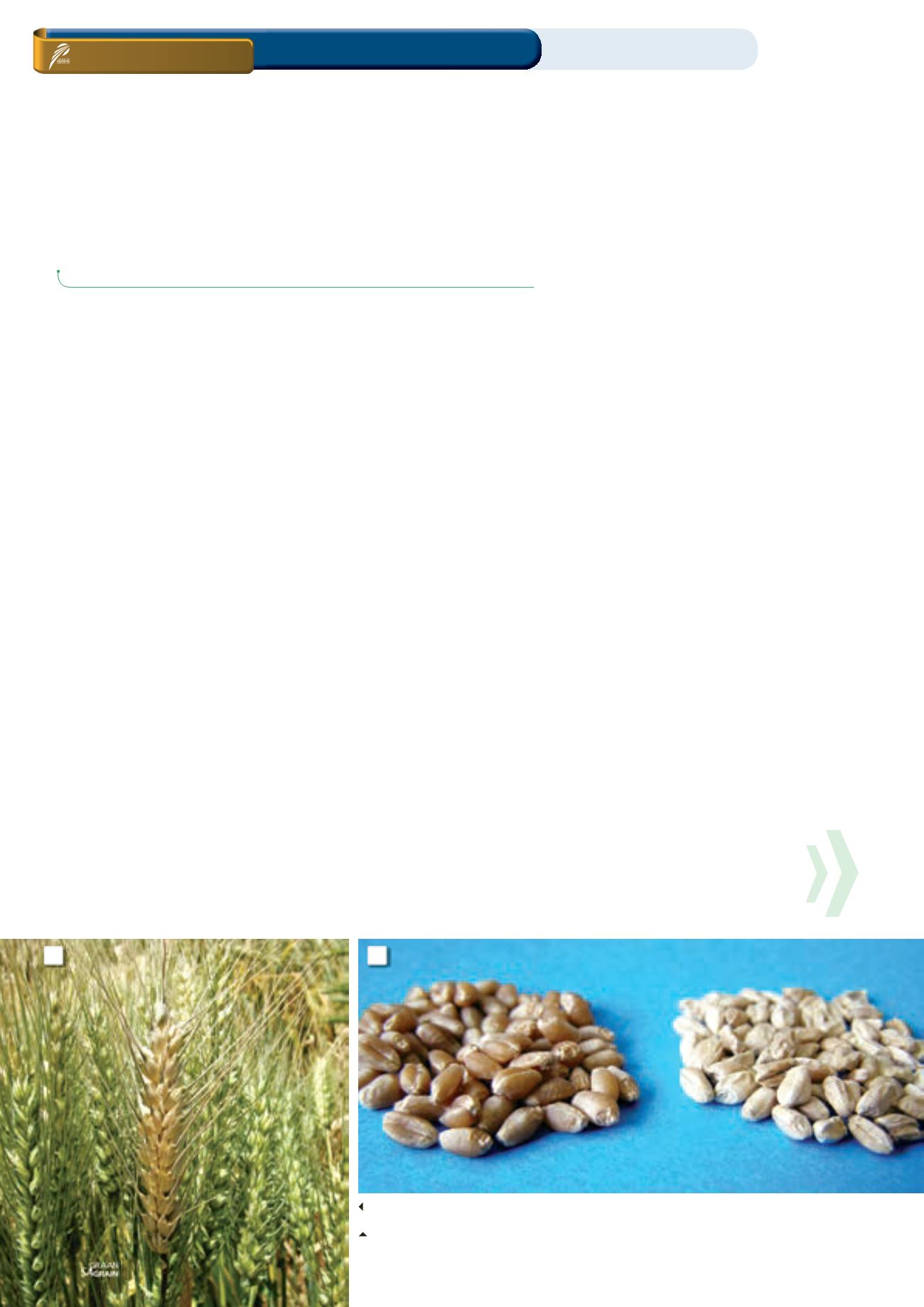

The dangers of mycotoxin-producing
Fusarium species on wheat
W
heat is one of the most important staple food crops in
South Africa. Currently, wheat is produced in all nine
provinces. The production areas of wheat depend on
the soil type, soil depth, soil water content, the environ-
ment and the availability of irrigation in some environments.
The major limiting factors of wheat production in South Africa are
diseases and pests, higher input costs, a lack of competitive edge
compared to other crops, yield stability, quality and profitability for
producers.
Fusarium head blight, also known as ear blight or scab, is one of
the most important diseases occurring on wheat under irrigation. It
increases yearly in incidence and severity worldwide, due to the use
of susceptible cultivars and an increase in the adaptation of conser-
vation agricultural practices.
Since the disease was initially recorded on wheat, barley and other
small grains, 17 different Fusarium species have been associated
with the disease worldwide.
Fusarium graminearum
is the species
that predominates internationally (85%), followed by
F. culmorum
and
F. avenaceum
. Most Fusarium fungi are soil-inhabiting and may
grow on living plant material as well as on dead organic material (as
facultative saprophytes).
In South Africa, Fusarium head blight was observed for the first
time in the 1980's on irrigated wheat in the North West Province.
Fusarium head blight is recognised by the appearance of one or
more prematurely blighted spikelets within a single head after flow-
ering (
Photo 1
).
The disease can spread throughout the ear (via the rachis), taking
on a bleached straw colour, whereas healthy plants remain green.
Peach to pink fungal mycelium and conidia form on severely in-
fected kernels (
Photo 2
). Most infections result in reduced kernel
number, kernel weight, and grain quality and spikelet sterility, and
can cause yield losses of up to 70% under high infection. In con-
trast, infections that occur during the late stages of kernel develop-
ment will have limited impact on yield.
In general, barley is more resistant to Fusarium, since the spikelets
are enclosed in the flag leaf sheath during flowering, probably re-
ducing the chances of infection. In some wheat cultivars, the reten-
tion of anthers during flowering and the presence of certain alleles
of the dwarfing gene can significantly affect Fusarium head blight
susceptibility.
Irrigation producers are encouraged to select their wheat varieties
carefully. As shorter potentially higher-yielding varieties are closer
to the ground, the higher risk of the optimal micro-climatic condi-
tions being present around the ear during flowering for longer
periods exists, making them more prone to Fusarium head
blight susceptibility. Varieties with a good level of resistance are
preferable.
Fusarium-infected grain may become contaminated with my-
cotoxins such as trichothecenes, moniliformin and fumonisins.
The predominant mycotoxins are trichothecenes that are a group
of secondary metabolites produced by different Fusarium fungal
species.
In recent years, there has been a major focus on food safety around
the world, which has concentrated on the trichothecenes and zea-
ralenone (ZEA). These trichothecenes include deoxynivalenol
(DON), 15-acetyldeoxynivalenol (15-DON), diacetoxyscirpenol (DAS),
nivalenol (NIV), 4-acetylnivalenol (4-ANIV), 3-acetildeoxynivalenol
(3-DON), and 4,15-diacetylnivalenol (4,15-Daniv).
Fusarium graminearum
is a type B trichothecene producer, includ-
ing DON, acetylated derivatives including 3-acetyl (3-ADON),
15-acetyl (15-ADON) and Nivalenol (NIV) chemo types. Zearalenone
is always more abundant in maize than in wheat and barley.
Deoxynivalenol is more commonly known as vomitoxin, a name
given by pig growers who associated vomiting with the consump-
tion of contaminated maize kernels. Kernels are contaminated with
toxins and are infected with the fungus. It was also called ‘the refusal
factor’ because pigs refused maize containing this mycotoxin.
CATHY DE VILLIERS
and
SCOTT SYDENHAM,
ARC-Small Grain Institute, Bethlehem
1: Fusarium head blight is recognised by the appearance of one or more prematurely
blighted spikelets within a single head after flowering.
2: Peach to pink fungal mycelium and conidia form on severely infected kernels.
1
2
ON FARM LEVEL
Mycotoxin / Fusarium / Wheat
Integrated pest control
Oktober 2016
78

















